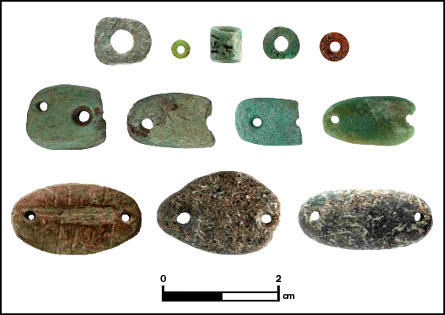Green reapers
First farmers cultivated an interest in green stone beads
Fledgling farmers in the Middle East treasured ornamentation as much as irrigation. These ancient villagers traveled great distances to obtain green stone for making beads and pendants that held special meaning for them in a brave new agricultural world, a new study finds.

Bead-making began by 110,000 years ago in what’s now Israel. But an emphasis on green beads emerged only about 11,000 years ago in concert with the agricultural revolution, say archaeologist Daniella Bar-Yosef Mayer of the University of Haifa in Israel and geologist Naomi Porat of the Geological Survey of Israel in Jerusalem.
“Because beads in white, red, yellow, brown and black colors had been used earlier, we suggest that the occurrence of green beads is directly related to the onset of agriculture,” Bar-Yosef Mayer says.
Green jewelry mimicked the color of young leaf blades, thus signifying a wish for successful crops and fertility, in her view. Green beads remain popular in agricultural groups today. Based on meanings attributed to these ornaments over the past few centuries, green beads originally served not only as fertility charms but as amulets to ward off the evil eye, the researchers propose online this week in the Proceedings of the National Academy of Sciences.
Mesopotamian texts from around 5,000 years ago mention the evil eye, a belief in a kind of curse caused by a person praising someone while looking enviously at that person. Evil eye traditions still exist, especially in Mediterranean and Aegean regions. It’s not known when evil eye beliefs originated, but they go back at least to the increasing complexity of spiritual belief that occurred at the dawn of agriculture, the Haifa scientist hypothesizes.
Archaeologist Debby Hirshman, curator of prehistoric cultures at The Israel Museum in Jerusalem, welcomes Bar-Yosef Mayer and Porat’s investigation. “To the best of my knowledge, they are the first to discover that the initial appearance of groups of green beads coincides with the beginning of agriculture,” she says.
No one knows for sure if early farmers associated green beads with fertility and protection against the evil eye, although it’s a plausible idea, Hirshman notes.
Bar-Yosef Mayer and Porat examined 221 beads of various colors that had already been excavated from eight Israeli sites. Four of the sites contained remains of the transitional Natufian culture, which from 13,000 to 11,500 years ago established permanent settlements and began to cultivate cereals. The remaining sites represented farming villages dating from 11,500 to 8,200 years ago.
A large proportion of beads made by budding cultivators were green, unlike those of earlier hunter-gatherers in the region. In the hunter-gatherer groups, green beads showed up occasionally but in small numbers. At Natufian sites, 45 of 116 beads were green. At later sites, 46 of 105 beads were green. Unpublished analyses by the two researchers find comparable proportions of green beads at 12 other early farming sites.
Over time, ancient farmers traveled increasingly greater distances — sometimes to sources located more than 100 kilometers away — to obtain green stone for beads, the researchers found.
A handful of double-holed, oval pendants found at the Israeli sites, made of green or brown apatite, probably symbolized shiny sea shells called cowries that Natufians and ensuing farmers also used as fertility charms, Bar-Yosef Mayer suggests.
The Natufian culture launched major changes in spiritual and ceremonial practices that influenced many later societies, remarks archaeologist Leore Grosman of The Hebrew University in Jerusalem. “Consequently, the new connection between the color green and warding off the evil eye is justifiable,” she says.







